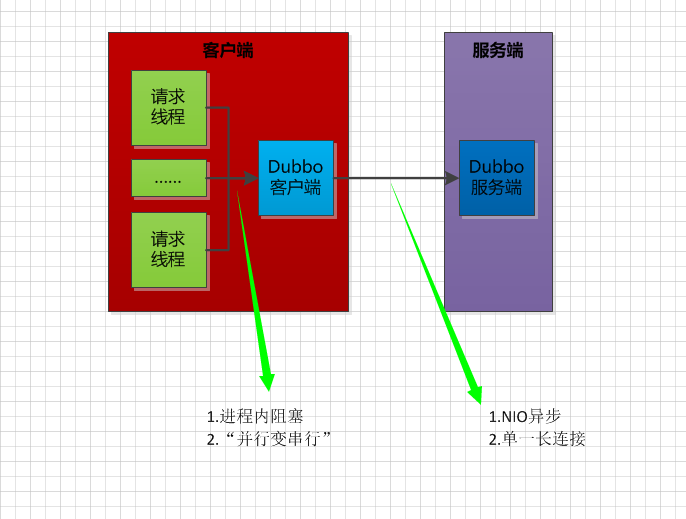最近被问到一个问题: 有依赖关系的两个dubbo服务。通过TCP进行连接时候,他们之间的连接是怎么控制的?怎么达到一个合理的数量?
我们从一个例子开始吧:一个订单服务 OrderService,IP为192.168.0.110 连接了商品服务 ProductService, ip 为192.168.0.111 ,其中订单服务中的方法比较多,并且很多请求也刚好路由到192.168.0.111的 ProductService 服务。那问题就来了:110机器作为客户端是怎么控制连接数的?会不会无限量地和111机器进行TCP连接?
我们先看一下Dubbo的官方文档对“连接控制”的说明文档 : http://dubbo.apache.org/zh-cn/docs/user/demos/config-connections.html 。
在xml配置方式中xml accepts="10" 和 connections="10" 分别在服务端和客户端进行了相应的连接控制。下面我们看一下源码,追一下连接控制的原理。
我们看一下DubboProtocol.java的创建客户端tcp连接的方法,int connectNum正是每个客户端对服务端的tcp连接数,默认是1,当然可以修改成更大。默认是1,这样一个客户端的调用service数最多也不会超过1000吧。这样就不会出现单机创建TCP连接数过多的问题。
1
2
3
4
5
6
7
8
9
10
11
12
13
14
15
|
private List<ReferenceCountExchangeClient> buildReferenceCountExchangeClientList(URL url, int connectNum) {
List<ReferenceCountExchangeClient> clients = new ArrayList<>();
for (int i = 0; i < connectNum; i++) {
clients.add(buildReferenceCountExchangeClient(url));
}
return clients;
}
|
客户端和服务端是一对一的,建立长连接,那么如果客户端并发访问,他们是怎么和服务端交互的呢?
经过看代码:

下面咱们试图从代码中找到痕迹。一路追踪,我们来到这个类:com.alibaba.dubbo.remoting.exchange.support.header.HeaderExchangeChannel.java,先来看看其中的request方法,大概在第101行左右:
1
2
3
4
5
6
7
8
9
10
11
12
13
14
15
16
17
18
19
20
| public ResponseFuture request(Object request, int timeout) throws RemotingException {
if (closed) {
throw new RemotingException(this.getLocalAddress(), null, "Failed to send request " + request + ", cause: The channel " + this + " is closed!");
}
Request req = new Request();
req.setVersion("2.0.0");
req.setTwoWay(true);
req.setData(request);
DefaultFuture future = new DefaultFuture(channel, req, timeout);
try{
channel.send(req);
}catch (RemotingException e) {
future.cancel();
throw e;
}
return future;
}
|
注意这个方法返回的ResponseFuture对象,当前处理客户端请求的线程在经过一系列调用后,会拿到ResponseFuture对象,最终该线程会阻塞在这个对象的下面这个方法调用上,如下:
1
2
3
4
5
6
7
8
9
10
11
12
13
14
15
16
17
18
19
20
21
22
23
24
25
| public Object get(int timeout) throws RemotingException {
if (timeout <= 0) {
timeout = Constants.DEFAULT_TIMEOUT;
}
if (! isDone()) {
long start = System.currentTimeMillis();
lock.lock();
try {
while (! isDone()) {
done.await(timeout, TimeUnit.MILLISECONDS);
if (isDone() || System.currentTimeMillis() - start > timeout) {
break;
}
}
} catch (InterruptedException e) {
throw new RuntimeException(e);
} finally {
lock.unlock();
}
if (! isDone()) {
throw new TimeoutException(sent > 0, channel, getTimeoutMessage(false));
}
}
return returnFromResponse();
}
|
上面我已经看到请求线程已经阻塞,那么又是如何被唤醒的呢?再看一下com.alibaba.dubbo.remoting.exchange.support.header.HeaderExchangeHandler.java,其实所有实现了ChannelHandler接口的类都被设计为装饰器模式,所以你可以看到类似这样的代码:
1
2
3
4
5
6
| protected ChannelHandler wrapInternal(ChannelHandler handler, URL url) {
return new MultiMessageHandler(
new HeartbeatHandler(
ExtensionLoader.getExtensionLoader(Dispather.class).getAdaptiveExtension().dispath(handler, url)
));
}
|
现在来仔细看一下HeaderExchangeHandler类的定义,先看一下它定义的received方法,下面是代码片段:
1
2
3
4
5
6
7
8
9
10
11
12
13
14
15
16
17
18
| public void received(Channel channel, Object message) throws RemotingException {
channel.setAttribute(KEY_READ_TIMESTAMP, System.currentTimeMillis());
ExchangeChannel exchangeChannel = HeaderExchangeChannel.getOrAddChannel(channel);
try {
if (message instanceof Request) {
.....
} else if (message instanceof Response) {
handleResponse(channel, (Response) message);
} else if (message instanceof String) {
.....
} else {
handler.received(exchangeChannel, message);
}
} finally {
HeaderExchangeChannel.removeChannelIfDisconnected(channel);
}
}
|
我们主要看中间的那个条件分支,它是用来处理响应消息的,也就是说当dubbo客户端接收到来自服务端的响应后会执行到这个分支,它简单的调用了handleResponse方法,我们追过去看看:
1
2
3
4
5
| static void handleResponse(Channel channel, Response response) throws RemotingException {
if (response != null && !response.isHeartbeat()) {
DefaultFuture.received(channel, response);
}
}
|
熟悉的身影:DefaultFuture,它是实现了我们上面说的ResponseFuture接口类型,实际上细心的童鞋应该可以看到,上面request方法中其实实例化的就是这个DefaultFutrue对象:
1
| DefaultFuture future = new DefaultFuture(channel, req, timeout);
|
那么我们可以继续来看一下DefaultFuture.received方法的实现细节:
1
2
3
4
5
6
7
8
9
10
11
12
13
14
15
16
| public static void received(Channel channel, Response response) {
try {
DefaultFuture future = FUTURES.remove(response.getId());
if (future != null) {
future.doReceived(response);
} else {
logger.warn("The timeout response finally returned at "
+ (new SimpleDateFormat("yyyy-MM-dd HH:mm:ss.SSS").format(new Date()))
+ ", response " + response
+ (channel == null ? "" : ", channel: " + channel.getLocalAddress()
+ " -> " + channel.getRemoteAddress()));
}
} finally {
CHANNELS.remove(response.getId());
}
}
|
留一下我们之前提到的id的作用,这里可以看到它已经开始发挥作用了。通过id,DefaultFuture.FUTURES可以拿到具体的那个DefaultFuture对象,它就是上面我们提到的,阻塞请求线程的那个对象。好,找到目标后,调用它的doReceived方法,这就是标准的java多线程编程知识了:
1
2
3
4
5
6
7
8
9
10
11
12
13
14
| private void doReceived(Response res) {
lock.lock();
try {
response = res;
if (done != null) {
done.signal();
}
} finally {
lock.unlock();
}
if (callback != null) {
invokeCallback(callback);
}
}
|
这样我们就可以证实上图中左边的绿色箭头所标注的两点。
参考链接:https://blog.csdn.net/joeyon1985/article/details/51046548

